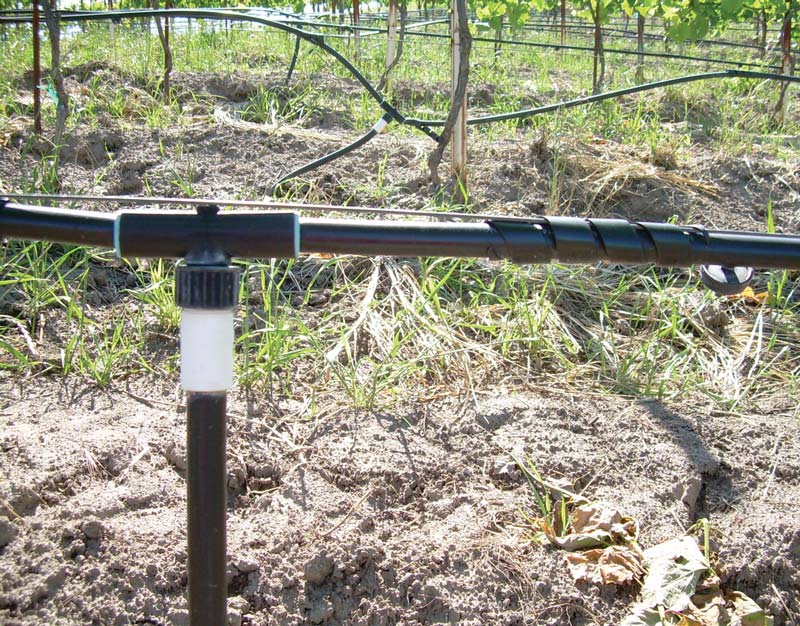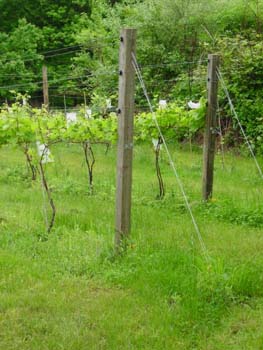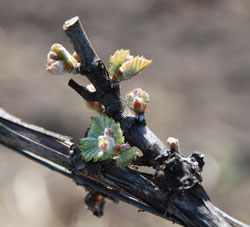At the time that I am writing this column we are in the midst of the wettest year here on the Central Coast of California since 1998 (well over 30 inches/76 cm of rain in a winter!), and a lot of vineyardists and winemakers here in California are talking about water: Drought, rain, soil, irrigation . . . the resurrection of a long-lost lake. Since it’s been almost seven years since we discussed water needs in the vineyard in this column, it is a good time to check new innovation and some tried and tested strategies for using water to our greatest advantage in growing great wine.
The good news: In most temperate areas of the U.S. free of drought conditions, irrigation will not be necessary to produce ripe fruit in a backyard vineyard. If your home ground receives 20–25 in. (50–65 cm) of rain per year, you may be able to dry farm your grapes, which will erase the cost of establishing an irrigation system and can rely on just some extra hose around in case those vines need a rare drink in an extended dry, hot spell. The Eurasian grapevine requires relatively little water to produce a bottle of wine. Even in California, about 5–6 gallons (19–23 L) of water will historically produce a bottle of wine in arid conditions (12 in./30 cm of rain). With that in mind, let’s take a close look at irrigating the home vineyard so we can make a smart decision on if you need to provide supplemental irrigation and, if you do, how and when to best apply it.
Vines and water: Let’s start with a fundamental understanding of what a vine does with water, and what happens without it. A grapevine, like all plants and most animals, is a vascular system that uses liquid to transport nutrients and life-sustaining chemicals through its vegetal tissue. Water moves through a vine by osmosis — just like a wick in a glass of water. The leaves give off water vapor vis-à-vis photosynthesis through the back of the leaves. As the vine respires, the whole spongy interior of the vine dries out and pulls more water from the root hairs into the vine’s roots, tap root, trunk, cordon arms, canes, shoots, and up to the growing tips. That fluid feeds the vines and keeps it moist and turgid, and is then respired as water vapor through the stomata found on the back of a vine’s leaves.

In drought conditions, vines have some survival mechanisms in the short term, but will droop, desiccate, shut down, and fail to ripen its crop if the drought conditions persist as dry soil at root level. It is vital to keep a grapevine healthy enough to produce ripeness and sugar in the berries, to ripen phenolically as well as simply sweetening. In order for this to happen they do require water at root level. Soil dryness between waterings is fine — even helpful to wine quality after flowering — but a vine in purely dry soil won’t last more than a month or two without shutting down and giving up on the vintage.
Vines do most of their work between 1.5- and 5-ft. (0.45- and 1.5-m) deep in the soil (although vine roots can reach more than a 100-ft./30-m deep in some soils), so the water status of a soil profile is most important in that zone. The old technology would have us put an Irrometer in the soil with ceramic tips measuring the “pull” of the dry soil against the liquid inside. I felt a bit mature looking through the modern options for soil moisture monitoring in researching this article. The soil probes I’m used to have gone the way of the cathode tube black and white television!
Technology and Vineyard Irrigation
Today we have some options and advances we can rely on to help us make informed decisions on vineyard irrigation. Let’s take a look at what’s new or improved (or not), and find the tools that are the best for our specific farming goals.
Soil moisture monitoring: From $12 to $1,500 (USD), you have hundreds of options for electronically or remotely sensing soil moisture, but there are cheaper and more hands-on ways of monitoring too. Just use a search engine to find “soil moisture monitoring” and take a look for a solution that makes sense for your budget and your location. Three depths for monitoring are recommended: 12 in., 18 in., and 24 in. (30, 45, and 60 cm); the critical depth for measuring soil wetness is 12–36 in. (30–90 cm); and I like to know when the soil dries at 12 in. (30 cm), and starts drying out at 18 in. (45 cm) to add some supplemental irrigation. Irrometers are the old analog technology but rarely fail and never need batteries or charging. If you do choose to use the old (but tried-and-true) Irrometer, make sure you do your upkeep and fill the reservoir with dyed water to keep them working.
New weather station technology that can help us determine best watering practices: Back in the early days of U.S. winegrowing and up to as recently as the 1980s, weather conditions were recorded by a few government employees and farmers for their own use. We are now in a golden age of climate science and weather reporting. For a few hundred dollars you can set up an advanced weather station in your backyard that will calculate degree growing days, rainfall totals, and even an advanced concept called evapotraspiration or EtO. EtO measures how much water is used by an acre of grasslands on any given 24-hour period.
In most temperate areas of the U.S. free of drought conditions, irrigation will not be necessary to produce ripe fruit in a backyard vineyard.
A farmer takes this data and applies a “crop coefficient” for their specific farming needs, and water use can be dialed in precisely. For those ultra-geeks who like data and difficult math — learn to use and exploit EtO for precise irrigation. My pro suggestion: Get a weather station a few grades higher quality and price than you think you need. This is a tool that will pay for itself by allowing you to understand degree days, ripeness, rainfall, and irrigation, as well as more data to consider in tweaking your farming for quality wine.
Better integration and access to localized weather data: Simply put, there are more professional weather stations at your computing fingertips than any moment in human history. And most of it is free! Between simple forecasts on NOAA (National Oceanic and Atmospheric Administration) and weather.com, to networked stations at wunderground.com, and agricultural area- and crop-specific reporting — there’s a good chance you won’t need to buy a weather station if there’s one within the mesoclimate of your home vineyard. If the weather/climate/rainfall is 90% similar where an existing weather station resides, I would use that data and let someone else worry about the maintenance.
True/False Quiz Time
Take the quiz, then we’ll discuss the answers. This is meant to cut through many of the common perceptions that surround wine vineyard irrigation. It will be impossible to give you all the technical expertise to design and implement an entire irrigation system in the space allowed in this column. In the next “Backyard Vines” we will look at different types of irrigation systems so you can choose a style to fit your vineyard. Installation can be researched further in books or on the internet, and most landscape design companies can help you size the pipes, valves, and pumps that may be necessary.
- T/F Stressing grapevines always produces superior fruit.
- T/F Growing regions that require irrigation are inherently inferior.
- T/F Turning the water off before harvest always improves wine quality.
- T/F Clay soils need to be irrigated more than sandy soils.
- T/F Mature grapevines compete with weeds for water and nutrients.
- T/F An irrigation system for a vineyard requires expensive equipment
- T/F All vineyards require some sort of irrigation system.
- T/F Vines cannot tell the difference between rain and irrigation.
- T/F Water is best applied at the base of the vine.
- T/F The best time to install irrigation is after the trellising is installed.
Answers Discussed: As you may have guessed, the answer to all 10 quiz items above are false. Let’s take a moment on each of these to explain and discuss.
- Healthy, mature grapevines produce the best fruit. There are regions in the world (the Rhône Valley comes to mind) where stressed vines on rocky hillsides produce intense, ripe fruit that makes beautiful wine. But let’s put that behind us for now because we do not live in those places. Let’s focus on keeping the vines healthy, viable, and alive. Sugar is produced by healthy green leaves turning sunlight, water, and nutrients into fruit. Stressed vines are more susceptible to disease, mildew, and rot. The old adage about stressing the vine is pure mythology in the New World . . . so let’s erase it from our head.
- Winegrowing regions in the world that get adequate rainfall as to make irrigation unnecessary often espouse their superiority over arid areas that require supplemental water. The Willamette Valley of Oregon is one of those places, a region that loves to compare itself to the Cote d’Or in Burgundy. But even the Oregonians are commonly irrigating young vineyards now to make sure that their investment in young vines matures into a producing vineyard. Arid areas that commonly receive less than 10 in. (25 cm) of rainfall a year (such as Santa Barbara County, California, and eastern Washington State) clearly show that irrigation-dependent areas can produce stunning wines of world-class quality.
- Turning the water off in the vineyard before harvest is yet another contentious issue. Letting the ground dry out will certainly hasten sugar accumulation, but most of the “Brix bump” is due to dehydration, NOT the evolution of phenolic ripeness. For those interested in making high-octane, monster wines this technique may get them the concentration they are looking for. But as an individual who likes wines with balanced fruit, alcohol, and acidity, I’m a big proponent of allowing the vine to keep green leaves through harvest. This keeps the vine from dehydrating the fruit, and a viable, live vine continues to ripen fruit naturally without dehydration.
- The opposite is true: Clay holds water much longer than sand, so clay soils actually require significantly LESS irrigation. Clay absorbs water while sand allows it to drain. Most soils are a mix of sand, loam, and clay. To determine your soil type, check out my piece in the June-July 2020 issue “Dirt Don’t Lie” or at https://winemakermag.com/technique/dirt-dont-lie-the-impact-of-soil-on-vineyards-and-wine
- Actually, most vines absorb water and nutrients from deep in the soil profile and do not compete directly with weeds. Weeds can compete for irrigation water that is applied sparingly, as it does not reach the appropriate depth for the vines’ root system. Weeds are competitive with young vines, though, and should never be allowed to grow into the canopy.
- An irrigation system is as easy or as expensive as you want to make it. If you can get by with using a hose and applying the water by hand, all the power to you! The only reason to drop serious money on an irrigation system is convenience and an increase in fruit and wine quality.
- If your vines stay viable and green throughout the growing season without supplemental irrigation, consider yourself blessed! Don’t install and pay for something you don’t need.
- Rainwater is far superior to ground or municipal water for irrigation. Municipal water often contains chlorine or fluoride byproducts (often from steel, uranium, and aluminum manufacturing), which are not needed for healthy growth and can actually be harmful to the vines. You may need to have your water tested by an agricultural lab to make sure it is usable for vineyard irrigation.
- Not true! If you are using drip line and drip emitters, spread them out so the vines have to spread out their roots to find water. You do not want the vines to make a single root ball at the base of the trunk and become dependent and lazy on the drip emitters. If the vine has equidistant drip emitters on either side, it will spread its root system out.
- Don’t do it! The FIRST thing to be installed in a vineyard project is the layout and irrigation. Make sure the irrigation is fully functional before putting in trellising and vines. Remember that at least half of a good irrigation system is underground, and you may have to trench across the rows.
Stay tuned for the October-November 2023 issue where I will be delving into the various irrigation systems and strategies you can employ to manage your vines.






